The rapid development of mobile technologies has revolutionary changed the healthcare sector. In today’s article, we are going to discuss one such change — doctor appointment booking app development — and how this apps are enhancing healthcare accessibility.
Mobile technologies are not only about entertainment. Beyond apps like Snapchat or Facebook, they also enable critical tools like scheduling software and online appointment systems that revolutionize healthcare access. But there is one thing that is, I guess, more important: mobile apps can impact and even change different spheres of our life. And healthcare is one of them!
📊 Healthcare IT Market: does it have a future?
When you are going to enter any market (healthcare, food delivery, hotel booking, or if you want to build a physiotherapy app), it’s better to start with research. It will help you to find out market’s current state and perspectives, shortcomings and possible issues. Luckily for you, we have prepared an overview of the healthcare IT market that will dispel all your doubts about medical app development, focusing on doctor appointment apps. Read on!
Current state and perspectives
According to Markets and Markets, the global healthcare IT market is going to reach $280 billion by 2026 with the annual growth rate of about 16%. The share of the mobile sector (which is about $26 billion as of 2017) also amazes since it’s reported about 17% and higher yearly growth.
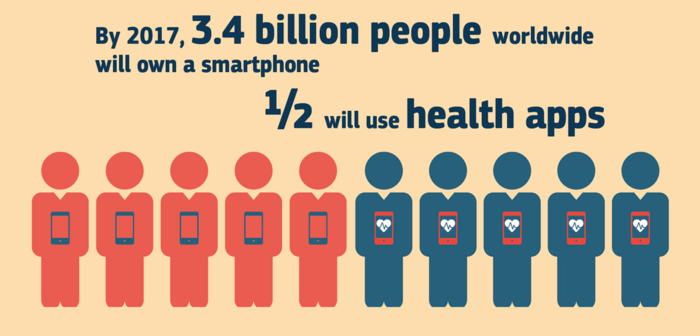
Statistics by European Commission
Modern doctors are able to provide a larger number of service using fewer resources due to the rapid IT development of the field. This is confirmed by the following statistics:
- 80% of physicians are confident smartphone and medical apps users.
- 25% of doctors use such apps to provide patient care with their help.
- At least every second user runs a healthcare app.
However, before starting the development, you should also consider possible pitfalls to successfully avoid them. What are they? Let’s see!
Main issues of the industry
Will you believe me if I tell you that there were about 259,000 mHealth apps in app stores in 2016? However, not everyone succeeds in the market and many good ideas fail due to the lack of proper preparation or the inability to solve common issues of the industry.
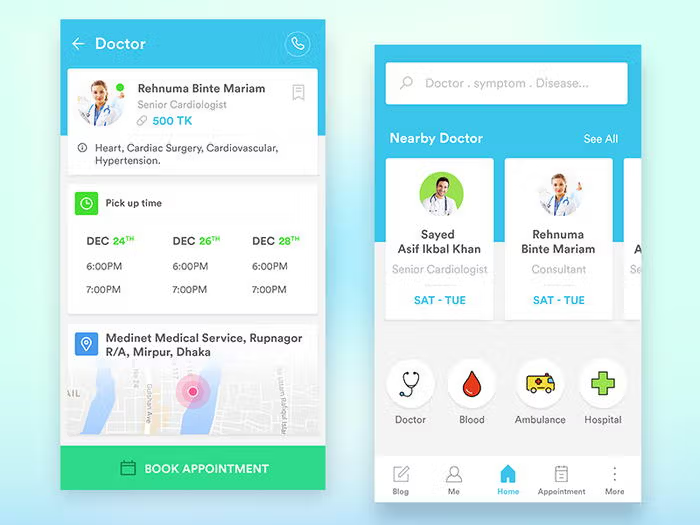
Make sure your app solves industry's issues (image by Audacity IT Solutions Ltd)
What should you keep in mind during the development?
- Solve a specific problem of the target audience. Many apps try to provide users with an as wide range of services as possible but eventually any service is provided at the proper level. In this article, we will focus on company-backed doctor appointment mobile app development tailored for remote consultations.
- Put usability in the center. In the fast-living modern world users are not tend to spend a lot of time waiting or trying to figure out how to use an app. Even if you promise them the lowest prices and the best professionals, you can’t hold them without the user-centered interface and a perfect UX part.
- Since healthcare is a pretty intimate sector, make sure your project meets all privacy and security standards. How to fit your application to the requirements of different countries and regions we will tell you a little bit later, so read on.
But now it’s time to move on to our doctor appointment booking app development tips!
🤓 Steps of Doctor Appointment App Development
Building a doctor's appointment app is a challenging, but very exciting task. Below is a step-by-step guide that will help you develop a real-world application that is not only high quality, but also easy to use and easily scalable in the healthcare industry in 2026.
1. Conduct Market and Customer Research
First of all, it is necessary to analyze the scope of competitors and users: their needs and problems they face. Check the gaps in the market using information from surveys and reports and evaluate how your doctor booking app can meet those needs through remote consultation options. Identify your app's unique value proposition (UVP), which could be integrating with telemedicine and/or offering specialized appointment scheduling or multilingual support.
📌 Considering the health app development cost is also crucial at this stage to ensure your budget aligns with your app's scope and features.
2. Define feature and functionality specifications
Make a list of the core functionality that should be provided for patients, physicians, and practice managers. The most important data for patients includes physician profiles, patient booking details, and payment features for seamless appointment updates. Doctors need equipment for making appointments and registering patients. Administrators need analytics and application dashboards.
You should also take care to ensure compliance with medical regulations such as HIPAA or GDPR to handle sensitive data responsibly.
3. Choose the Technology Stack
Select a technology stack aligned with your app’s goals:
- Frontend: Cross platform with either React Native or Flutter.
- Backend: Node.js, Ruby on Rails, or Python for scalable and secure operations.
- Databases: Such a system may use PostgreSQL or MongoDB for the individual data management.
- Third-Party APIs: For geolocation, you can use Google Maps, for messaging – Twilio, and for payments – Stripe.
4. Designing the App’s Functional Specification and Layout
Once the technology stack is defined, you can start creating a wireframe of the structure and functionality of the mobile app, which will give you a basic idea of how the app will look and function. The next step is to develop a doctor appointment app prototype, which is a basic version of the app that consumers can test.
Once the prototype is complete, the design team can start working on the UI/UX design of the app. They should choose an acceptable color scheme, font, and layout that is visually appealing and easy to use. Make sure your app design is consistent and optimized for all screen sizes and orientations.
5. Develop the Minimum Viable Product (MVP)
Begin with the fundamentals to test your app concept - this is your MVP. This stripped-down version allows you to get to market faster and gather feedback from early users before pivoting further and adding priority features. Based on this, you can make changes to the app or discontinue it before incurring significant costs.
6. Implement data security measures
When you build an application for a doctor's appointment, you need to pay special attention to complying with all security policy standards, for example, use security standards such as encryption (SSL/TLS) for data transmission and storage. Implement multifactor authentication (MFA) for accounts and payment gateways that accept credit card information. It is also important to frequently check the application for vulnerabilities to restore user trust.
7. Testing
Performance and security testing is very important in order to identify any problem or weakness in a particular application. It evaluates functionality, usability, and performance. It is used to simulate real-world use to check the load and deviations that can occur in different uses of the application.
8. Launch, monitor, and update the app
Prepare for publication on Google Play and the Apple Store. Make sure your app also meets all the guidelines of your chosen platform. It's also important to implement your marketing strategy to promote your app in the market, such as using social advertising or content marketing.
After launching your app, track user feedback and performance. If necessary, work on bug fixes, feature enhancements, and/or overall user experience improvements. Keep up to date with current technological advances as well as the latest regulations to make your app stand out from the crowd and stay compliant with the law.
⚙️ Development tips: your guide to building a doctor appointment app
According to SteelKiwi, only about 11% of medical apps offer users desirable and necessary features. That’s why, whether you're considering how to make a meditation app or a doctor appointment app, you should think carefully about your user’s flow before starting the development. In other words, imagine the path of a typical patient in your app: what features are essential for him, how does he move from one feature to another?
Luckily for you, we have already designed a list of must-have features of any doctor appointment app. Here they are!
👤 Profiles
Frankly speaking, people don’t like to create profiles and spend a lot of time writing their name, phone number, address or other personal information. However, healthcare is a very personalized services sector, so your users can’t avoid making their own profiles.

Profiles are essential part of any healthcare app (image by Sam Halpert)
What info should it include?
- Name and surname so doctors know how they can call you and make a record on your name.
- Address that is necessary to form a list of doctors located nearby from you.
- Age, sex and other data which may be crucial during the treatment process.
🔎 Searching
Let’s divide this feature into two and review them both.
Scheduling
After we're done with profiles, let's move to the central feature of your app - booking. And the first step here is choosing an appropriate date. Nothing difficult: just provide your users with an interactive calendar where they can set a day of appointment with only one tap.

An easy and intuitive booking process (image by Safitri)
Hint: for more convenience, provide users with the ability to choose a range of days (up to 3 or 4 but not more).
Other searching tools
However, there is a number of tools that can make the searching process even more precise. Using filters and sorting your users can find an appropriate doctor by such criteria as the doctor specialty, a price range, a proximity or others.
👨⚕️ Doctors’ profiles
According to the chosen date, the app will form the list of available doctors. But how should your users make a choice?

A doctor profile with all necessary info (image by forint)
So they don’t have such a problem, they should be able to browse doctors’ profiles. In this case, profiles may include the following information:
- Location (it would be great if you add a distance counter from a client to a doctor).
- Competence (doctor’s specialty, education, experience, professional certifications and so on).
- Reviews from other patients.
- Photos (of a workplace, for example).
⏰ Setting an appointment
When the right doctor is found, users can send a request for an appointment. If there are any additional questions or issues, they can be discussed in the built-in chat.
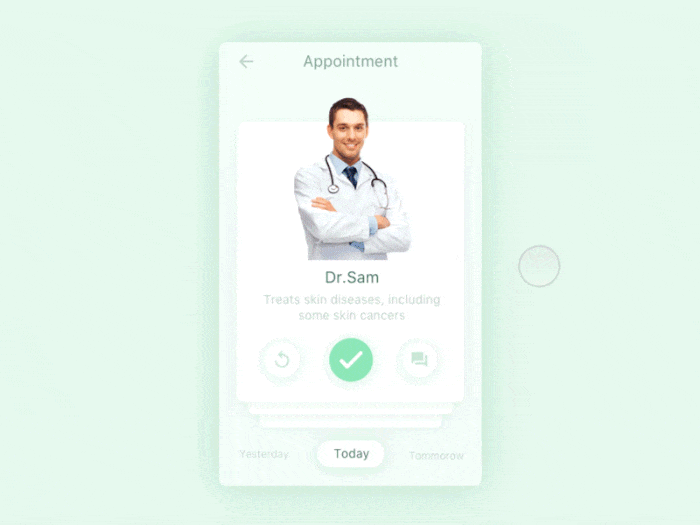
A built-in chat in a doctor appointment app (image by Kiran6390)
When everything is figured out (or if there weren’t any issues) the doctor confirms a request. The appointment is considered to be assigned. And it means that there is only one step left.
Hint: add reminders (push notifications) to your app that will notify users about the upcoming visit to a doctor.
💳 Payment system
The last feature on our list of MVP features is payments. Since your app is going not only help people but also bring you some profit, a common monetization model we can advise you is a fee from the service.
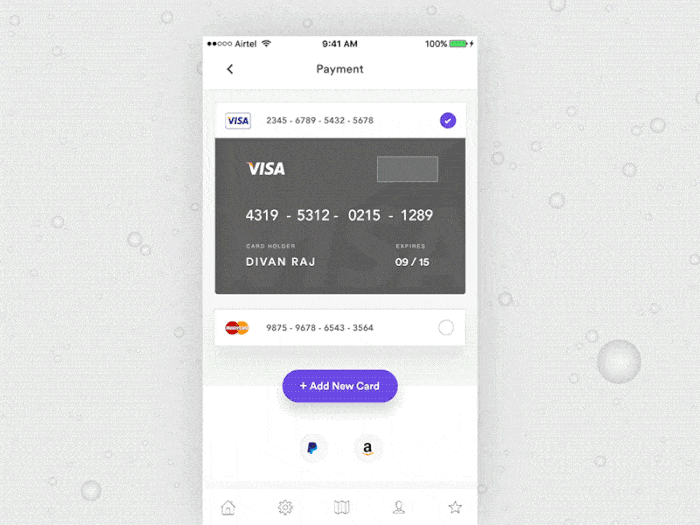
A fast and secure payment service(image by Divan Raj)
Also, if you don’t want to lose patients at this stage, the payment process should meet the following principles:
- It should be easy = users have to make as little actions as possible.
- It should be fast = try to lower the processing time to the minimum.
- It should be secure = pay the special attention to the protection against frauds.
💡 3 cool features that will improve your doctor appointment app
You can achieve even better UX by implementing a number of useful features that are not on the MVP list but will definitely come in handy for users. What are they? Read on to find out!
📹 Telemedicine
It’s not a secret that a visit to a doctor can take about an hour or more. This is a fair toll if the patient needs a detailed personal examination but a lot of people just want to consult with a doctor and have no actual need to be with him in the same room. By integrating remote consultation through video conferences, patient booking systems and advanced appointment software can save time for patients while solidifying your company as a leader in the digital healthcare space.
For more information, read our article about telemedicine app development!
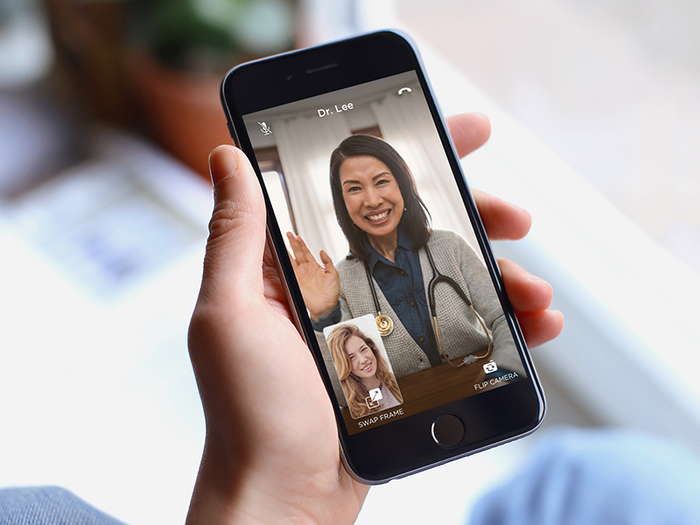
Telemedicine provides your users with a brand new experience (image by Brian Turley)
🗺️ Geolocation module
Another great feature is the in-app guide to the doctor office. Of course, it’s not a big problem to download Waze or use Google Maps to find the best way but having such a feature in your app may be a great advantage in the eyes of users.
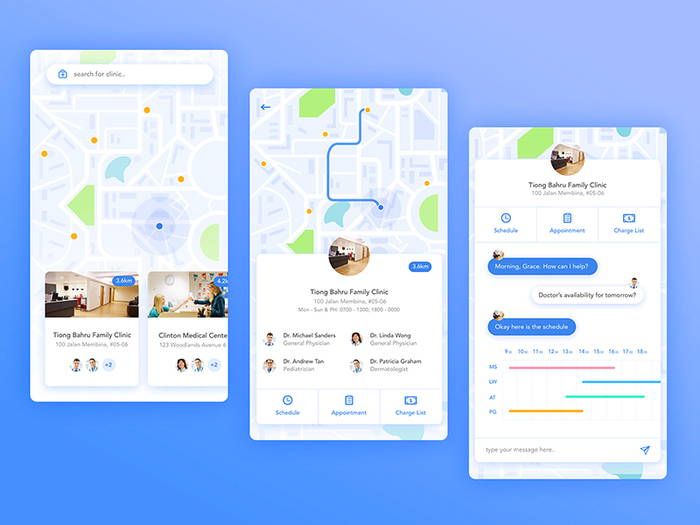
A guide to a doctor is a great addition to your app (image by grace saraswati)
🚨 Emergency services
Sudden injuries like twisted legs, broken bones or burns cause a lot of trouble and require emergency care. Thus, it would be extremely helpful to see the list of available emergency rooms in the area with info on the wait time. With this feature users will be able to visit a doctor who will start treatment as soon as possible.
Finally, we have reviewed essential and additional features of an mHealth app. But how much will it cost to build one? That’s what you’re going to find out right now!
💵 Plan your budget: what is the cost to make a doctor appointment app?
The exact cost of the doctor appointment application development depends on an hourly rate of your development team, a contract type and a complexity of your app. According to the estimation made by Stormotion developers, it will take about 350-480 hours to build the FrontEnd part of an MVP per platform (Android or iOS). Don’t forget about the UI as well: it will take about 60-70 hours more.
Also, clinic appointment app development of the BackEnd part will take about 250-300 hours.
With an hourly rate of $40 (typical for Eastern Europe; for North America and Western Europe an hourly rate is usually 3-6 times higher) the cost to make a doctor appointment app starts from $26,400. For more information you can read our article about the cost to develop a doctor appointment app like Zocdoc.
Contact us and our developers will make an estimation of your app project within 24 hours!
In addition to the estimation, our developers also prepared a list of tech tools that will ease the development. Check it out and feel free to use them during you build an app to make doctor appointments!
🛠️ Tech tips: 7 tools that will help you to create a doctor appointment app
- Symptom Checker API helps to identify what possible diseases a patient has. Based on this information, your app will determine the most appropriate doctors for further consultations.
- To implement an appointment scheduler you can use SimplyBook.me API.
- 10to8’s API is another great tool to manage and maintenance bookings.
- BetterDoctor API can be used to incorporate doctor data and search into your healthcare project.
- With help of Doctoralia API users can not only search for doctors but also read reviews from other patients and make online bookings right in the app.
- As a good tradition, we advise Stripe and Braintree SDKs as secure and fast-working tools for managing payments.
We have already learned development and technical tips but we have some more recommendations for you regarding healthcare app development services. Check out our business tips to find out how you can successfully compete on the market and turn your app into a profitable source of revenue.
☑️ Business tips: 3 more things to consider
In this subsection we have collected useful tips for you to help avoid common mistakes and maximize the effectiveness of your app.
1️⃣ Don’t underestimate wearables
It’s always important to follow the trends. Overtake your competitors in mastering new technologies and you will gain a favorable advantage.
According to the report by IDC, the number of shipped wearables increased by 20.4% during 2016-2017 years, hitting the critical mark at 125.5 million devices. Moreover, by 2026 this number will double to about 240 million units.
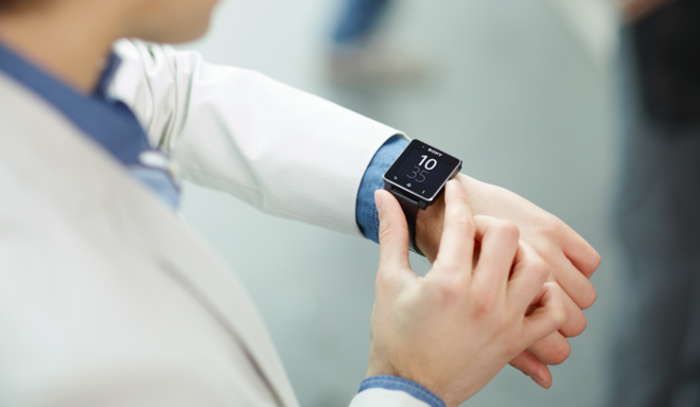
Wearables are getting more and more popular
So despite it’s not something to start with, keep this market in mind as your app’s revenue grows and you get more active users.
2️⃣ Comply with privacy and security standards
When it comes to collecting, storage and processing of information you should always remember about state regulations that put forward a number of requirements for such activities. Moreover, these standards differ from country to country so make sure your app complies with them before you face potential financial liability.
We gathered a number of laws that regulate privacy and security standards in different countries and regions of the world. Here they are:
- The United States. Medical apps that store and transfer PHI (Protected health information) must comply with HIPAA (Health Insurance Portability and Accountability Act).
- The United Kingdom. The major governing legislation here is the Data Protection Act.
- The European Union. There are two main directives that should be taken into consideration during the health and fitness app development - the Data Protection Directive 1995/46/EC and the e-Privacy Directive 2002/58/EC.
- Canada. The list of privacy requirements can be found in PIPEDA (Personal Information Protection and Electronic Documents Act).
3️⃣ Think about how you’re going to manage doctors’ listings
There are 2 options to choose from: you whether managing doctors’ profiles yourself through an admin panel or build a second app specially for doctors where they can edit details and manage appointments on their own.
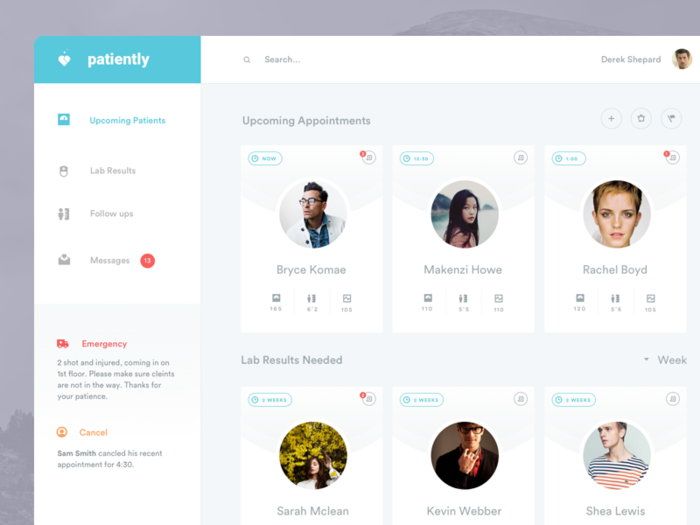
Doctors should have own mobile or web app to manage appointments (image by Knife and Fox)
Despite the development of a doctor app or web app will add a line to your expenses, in the long term it is a pretty cost-effective solution. It will not only help to provide patients with a more accurate data right from the doctors but also relieve you of the task to do it on your own.
👍 Benefits of Creating a Doctor Appointment App
With a convenient 24/7 system, a company-backed doctor booking app offering remote consultation services is reshaping the future of healthcare. These apps make it easier for patients to receive medical care and for doctors to provide customer service. Whether you're a developer planning to build an application for a doctor appointment or a healthcare facility exploring mental health app development, here are the top benefits of investing in a doctor's appointment app:
1. Enhanced Accessibility and Convenience
App-based doctor's appointments bypass existing barriers in the doctor-patient chain. Constant availability means that users can manage their healthcare needs on their own without having to make arrangements with healthcare systems. Users can:
- Schedule appointments anytime and anywhere in the app
- View doctors' schedules in real-time.
- Receive notifications about the next visit or appointment.
2. Operational Efficiency for Providers
Healthcare providers benefit greatly as digitization greatly simplifies the process of making an appointment. Key operational improvements include:
- Reducing the number of no-shows: Automated reminders and rescheduling options allow patients to stay on schedule.
- Simplification of administrative tasks: Some of the benefits include reduced patient intake times and scheduling time to allow physicians to serve patients.
- Better resource management: Doctors and clinics can track available time in real-time.
3. Improving communication between patients and doctors
Some applications include internal communication channels like messaging and teleconsultations, enhancing health monitoring and appointment management. Patients can clarify doubts or seek advice from their doctors without unnecessary visits, which increases trust and satisfaction.
4. Secure medical data management
Modern appointment apps, much like health insurance app development, ensure that all patient information is well protected and compliant with local laws such as HIPAA or GDPR. Digital medical records:
- Accessible to patients and doctors.
- They simplify the exchange of test results and prescriptions.
- Reduce paperwork and other administrative costs associated with record keeping.
5. Monetization opportunities
Doctor appointment apps open up various sources of revenue, including
- Separate options in the app that require additional payment
- Space for advertising related products and services related to the medical business.
- Commission models for making appointments.
Such options make such an app not only useful for people but also a profitable business.
Creating an app that helps users schedule a doctor's appointment is not just a business idea, it's an opportunity to help people become happier and healthier, and to give them the ability to stay connected.
🗃️ Case study: Doctor On Demand, Pager
The mobile healthcare market already knows successful examples of apps that allow to book your doctor's appointment. We propose to review 2 of them and find out what we can pick up from their experience.
Doctor On Demand
Doctor On Demand is a great example of a typical doctor appointment app. It has a nice-looking intuitive interface and all the must-have features that we have previously mentioned. The app available both on iOS and Android and has over 500 000 downloads according to Google Play Market.
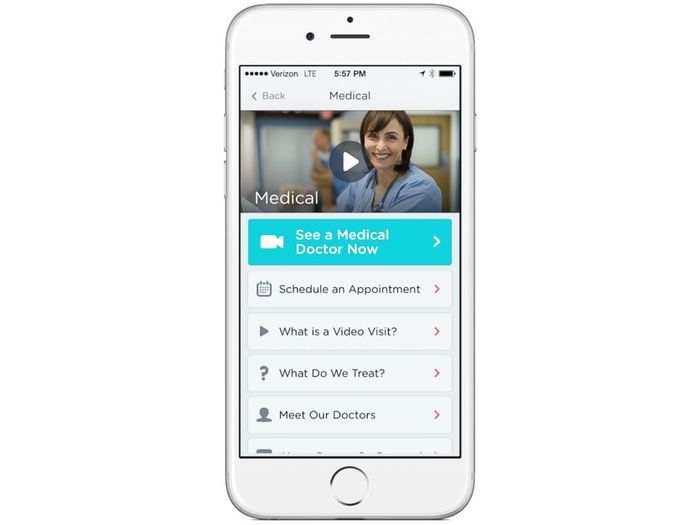
Doctor On Demand app
What features does the application provide to users?
- Ability to schedule your appointment or find a doctor who can examine you right away.
- Built-in map with pharmacies where you can buy prescription drugs.
- It is also possible to talk to a doctor using the in-app chat.
- You can also hold a video conference with a doctor instead of visiting his office.
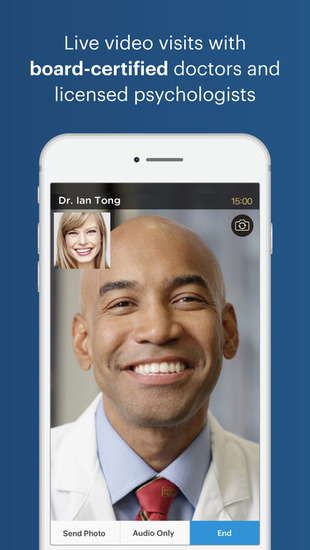
The app supports the telemedicine feature
Pager
The app was created by the co-founder of Uber and also hit the market success. It was designed to provide people with the ability to consult with doctors at any time and make the appointment organization process fast, easy and user-friendly.
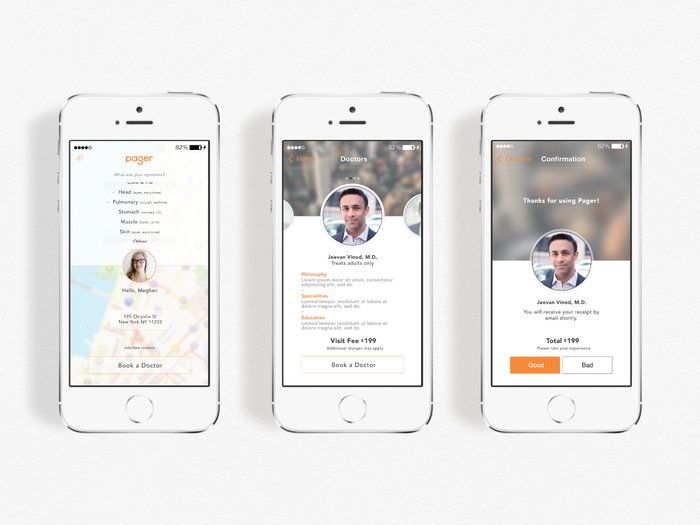
Pager app
Like Doctor On Demand app, Pager also allows you to chat with doctors right in the app or hold video conferences instead of making offline visits. Moreover, you can also ask a doctor to visit you at home, in your office or even in the hotel!

Pager app
❗ Conclusion
These were our tips & tricks on the doctor appointment app development. Feel free to use lists of MVP features and tech tools made by Stormotion developers when you decide to create your own mHealth app.
However, we will be happy to answer all of your questions, so we are looking for them. And don’t forget to contact us in order to get the accurate estimation of your app project!

![Stormotion client Max Scheidlock, Product Manager from [object Object]](/static/33294af91c38256bcd5a780ddc41861a/b0e74/max.png)


